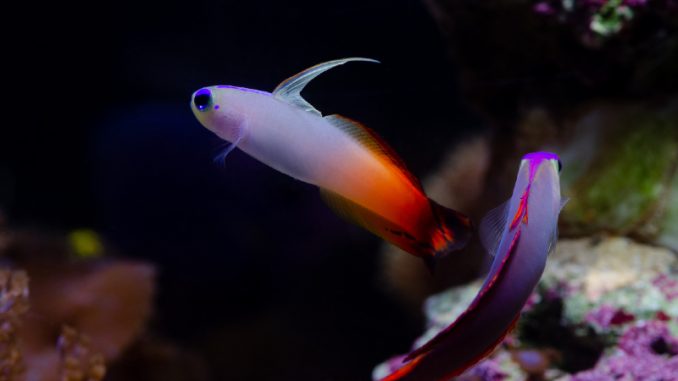
One of the luxuries about having a marine tank is being able to choose from a plethora of colorful fish when designing your setup.
Purple Firefish will catch your eye with their dazzling colors. They manage to stand out even though they live a solitary lifestyle, living alone at the bottom of the tank.
As a hardy species, they are easy to care for too. Beginners can allow themselves to be tempted and shouldn’t find themselves making many mistakes.
This article covers all the important information when it comes to Purple Firefish care. We will talk about their ideal habitat, preferred foods, how to breed them, and much more…
TABLE OF CONTENTS
Purple Firefish Facts & Overview
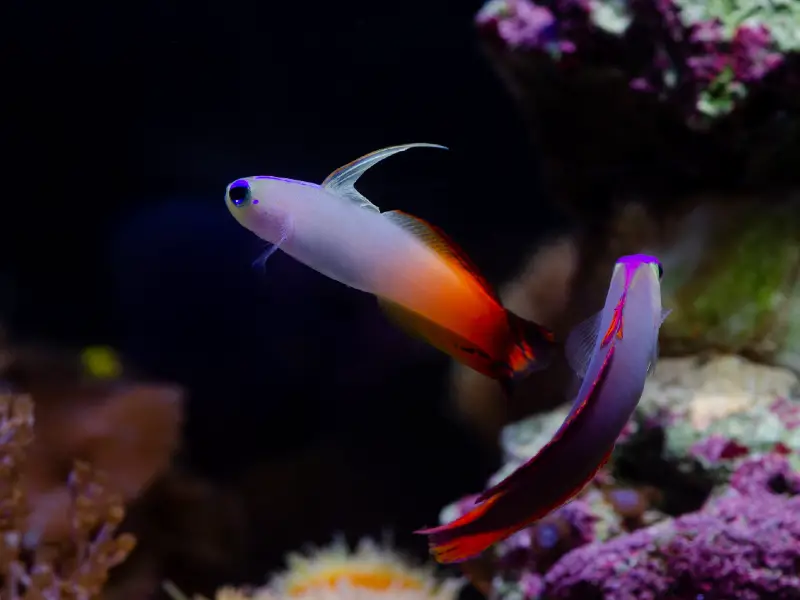
| Category | Rating |
| Care Level: | Easy |
| Temperament: | Only aggressive towards the same species |
| Color Form: | Purple, red, and some yellow |
| Lifespan: | Up to 3 years |
| Size: | Up to 4 inches |
| Diet: | Mostly carnivorous |
| Family: | Gobiidae |
| Minimum Tank Size: | 10 gallons |
| Tank Set-Up: | Marine with corals or live rock |
| Compatibility: | Peaceful community |
Purple Firefish is a saltwater species that goes by a few different names, such as the Elegant Firefish, Purple Dartfish, or Decorated Dartfish.
Their scientific name is Nemateleotris decora and they are part of the Gobiidae family. They are a type of dartfish, but they’re closely related to the gobies.
The species is native to the tropical climates of the Indo-West Pacific. They live around Mauritius, Samoa, the Ryukyu Islands, and other nearby areas.
By searching around online first, you should be able to find a stock of Purple Firefish near to you. Their price can vary a lot around the region of $30-$60, it depends on the store and the age/size of the fish.
Check for disease or injury before buying. If there are any problems, it’s safest to go to a different store.
Given the right quality of care, a Purple Firefish could reach 3 years old, but some could live even longer.
These are beautiful fish that are always showing off their personality. They make a great addition to small reef setups.
They aren’t too difficult to care for if you’ve done some research. They work well for people who are starting a saltwater aquarium for the first time.
Typical Behavior
This dartfish spends most of its time in the lower regions of the tank, keeping to itself in the search for food.
Purple Firefish are peaceful to other species, but they display aggression towards others of their own kind. They are usually limited to one per tank.
Some people have had success keeping a pair in the same aquarium, but it isn’t worth the risk.
They are happy living a solitary life. In the wild they are usually found living alone, only coming together to mate.
This is a reef safe species that leaves corals alone.
When stressed, Purple Firefish might hide away in caves, but the rest of the time they tend to be out and about.
Appearance
Purple Firefish boasts plenty of colors, lots more than just the purple that their name suggests. Their colors are vibrant and brighten up the tank as they dart around.
They have a long, slender body which is typically white, the color comes from their head and fins.
They have short dorsal and anal fins that stretch across the rear half of their body. These can vary in color from blues and purples to reds and oranges, but they are usually striped horizontally along the fin.
The same colors and pattern can be found on the small caudal fin at the back.
In front of the short dorsal fin is a narrow, long one that can change position from lying close to the body to standing up straight.
Hues of purple and yellow can be found on their head, surrounding their eyes. The eyes themselves are solid black.
A fully grown fish can reach up to 4 inches long, so they can fit into small reef aquariums.
It is very tough to determine the sex of Purple Firefish. There isn’t an easy way to do this by eye.
Habitat and Tank Conditions
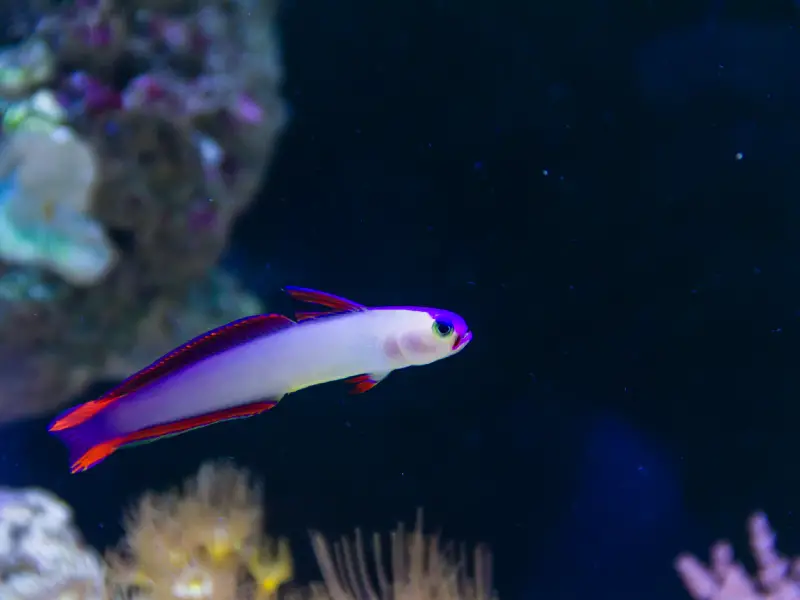
In the wild, these marine fish are found in the Indo-West Pacific. They originate in areas like Mauritius, Samoa, and the Ryukyu Islands (below Japan).
These locations are in tropical climates where the water is warm and alkaline.
Purple Firefish live at the bottom of reefs, at depths of up to 230 ft. They spend their time near to the substrate, which would be sand or coral rubble.
The reef offers plenty of protection if a Purple Firefish needs shelter from aggressive fish. Potentially being near to reef drop-offs, they may be exposed to strong currents.
These natural conditions must be recreated in your aquarium to keep your Purple Firefish healthy. This is simple to do, we’ll explain how to next.
Tank Conditions
Layer the bottom of the aquarium in a fine-grained, sandy substrate. Coarse gravels can scratch your fish, which is especially a problem for Purple Firefish because they spend so much time in the lower regions of the tank.
Create lots of hiding spaces around the tank that can be used as territories. You can use live rocks or corals since this species is reef-safe.
Keeping the water parameters at the correct levels is crucial for healthy fish. The temperature should be 72°F-80°F, pH should be 8.1-8.4, and specific gravity should be 1.020-1.025.
Standard aquarium lighting is fine. Purple Firefish enjoy water movement in the tank, but a powerful filter outlet should be enough.
Ensure that your tank has a tight-fitting lid because Purple Firefish are prone to jumping from the water.
What Size Aquarium do they need?
These fish are small, only reaching 4 inches, so they can be kept in small tanks of 10 gallons or more. They will appreciate any extra space you can provide though.
In very large tanks, you might be able to keep multiple Purple Firefish together because there would be plenty of space for them to have their own territory to escape each other.
This would always leave the risk of fighting though.
How Many Can be kept per gallon?
Purple Firefish show aggression towards other members of the same species, so you should only be keeping one individual per tank.
Tank Mates
This is a peaceful species for the most part. They are great options for a community aquarium, getting along fine with other popular marine fish.
Aggression is only displayed towards members of their own species. This may extend to other dartfish species, but not always.
Look out for any signs of aggression and separate the culprits if necessary. Keeping a single Purple Firefish as the only dartfish in the tank is the safest way to go.
Tankmates should be peaceful and of a similar size, opting to leave your Purple Firefish to their solitary lifestyles.
Some good examples include Clownfish, Green Chromis, Pajama Cardinalfish, Butterflyfish, and Blennies.
Invertebrates are a great way to diversify the activity in your aquarium. Shrimps and snails make very interesting tank mates and they pair well with Purple Firefish.
Corals are included as suitable invertebrates for your setup.
Can You Keep Purple Firefish Together?
There are few instances when Purple Firefish should be kept together. They are aggressive towards their own kind and will start fighting.
Some people keep a pair in a very large tank, but it is difficult to predict how your fish will react. This isn’t recommended, especially if you don’t have experience dealing with aggressive fish.
Diet
Purple Firefish are primarily carnivores, but they will eat whatever they can find suspended in the water column, including some manufactured aquarium fish foods.
Their natural diet in the wild consists of eating copepods and zooplankton, which are usually larval forms of animals like crustaceans. Try to replicate this for them at home.
Small meaty foods will be happily accepted. Try live or frozen varieties of brine shrimp, Mysis shrimp, or even pieces of finely chopped-up crustacean/mollusk meat.
A more affordable option is to use some dried foods like flakes and pellets. These may be more convenient but their nutrient content is significantly lower, so they shouldn’t be the only part of their diet.
A varied diet is important for keeping your fish healthy, as they’ll receive the widest range of nutrients.
Vitamin supplements are useful for maintaining the vibrant colors of your Purple Firefish. They aren’t essential but might be appreciated by your fish from time to time.
Try to feed your fish in small amounts 2-3 times a day. Spreading out their feeding is most similar to their natural behavior. It also eases the workload on their digestive system.
Care
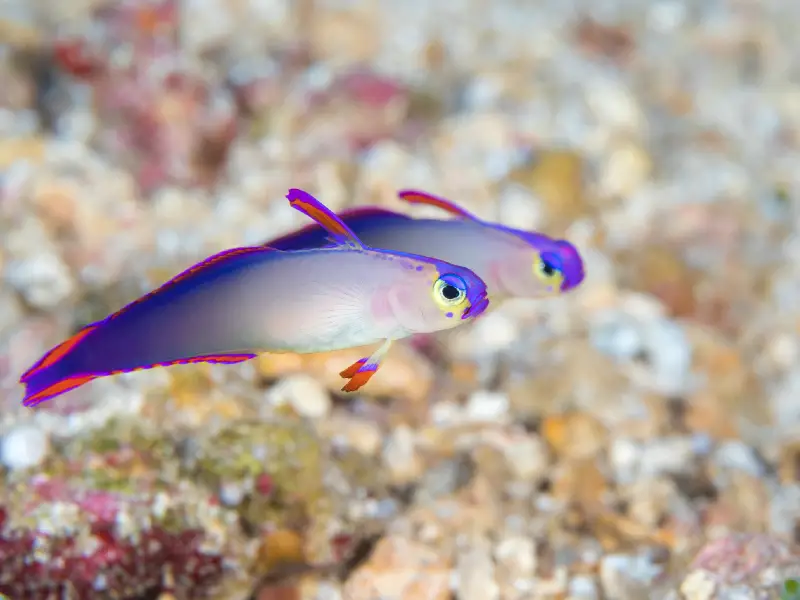
These are hardy fish that can withstand small changes in their environment, as long as problems are fixed quickly.
They are an excellent choice for beginners who may be new to keeping marine fish. They shouldn’t cause any issues if there is only one per tank.
After the aquarium has been set up and the fish have been introduced, care is largely about maintaining the tank. This means cleaning it regularly and ensuring that the water parameters remain constant.
Perform regular partial water changes to prevent the buildup of pollutants. Wipe away excess algae when you see it and frequently check that all your equipment is working correctly.
Their hardy nature makes them quite resistant to diseases, and they are quite capable of surviving should they contract would, if you treat them quickly.
The most common disease to look out for is called ich. This is a parasite that causes white spots to appear across the body of an affected fish.
The fish might start flashing too, where it rubs itself against surfaces in the tank.
There are treatments that you can buy from pets stores for ich. In fact, nowadays there are treatments available to remove most common pathogens.
Quarantine and treat infected fish in a separate tank so they don’t spread the disease throughout their community.
Breeding
Breeding Purple Firefish at home is difficult, but there are reports of it being done successfully in captivity.
The first problem is ensuring that you actually have a male and a female to mate since they are so tough to tell apart.
Getting them to become a mating pair is another challenge, but things get easier when raising the young.
Conditions will need to be perfect for mating to start. Maintain a stable environment with their preferred water conditions and use a consistent feeding schedule.
Try gradually warming the water to 80°F to act as a trigger for spawning.
It might take a while for spawning to occur, it could be six months or longer. When it finally happens, each spawning will produce between 400 and 500 eggs.
These will hatch after four days, releasing hundreds of tiny fry. You will need to feed these infusoria until they grow large enough to accept zooplankton and other similar foods.
The parents will guard and protect the eggs and the fry, looking after them as they reach the juvenile stage. It will take over a month for the fry to become juvenile Purple Firefish.
Are Purple Firefish Suitable for Your Aquarium?
There aren’t many reasons not to get a Purple Firefish. If you are setting up a marine aquarium, these should slot in without a problem.
They are hardy, easy to care for, peaceful (mostly), and can even be kept with corals. A wonderful beginner species.
One thing to consider is that you can only keep one per tank, to prevent fighting. You should also be wary if you already have another dartfish species in your tank.
They may not be the best choice if you want to start a breeding tank, but it can be done. Their feeding preferences can easily be catered for too.
Purple Firefish is a beautiful species that make a fabulous addition to a saltwater aquarium. They will spread their color around the bottom of your tank.
What does your Purple Firefish aquarium look like? Let us know about your setup in the comments below…

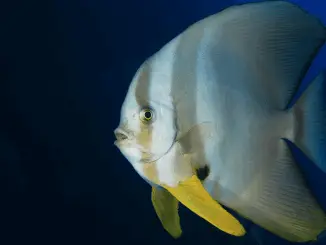
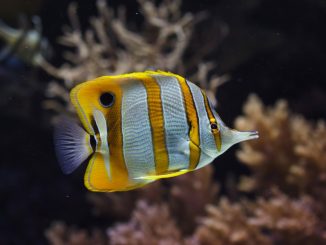
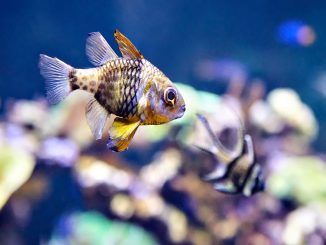

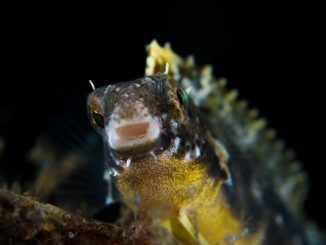
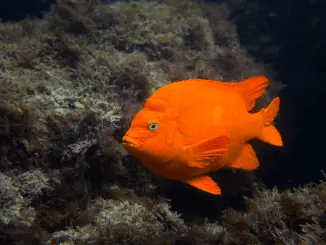
Be the first to comment